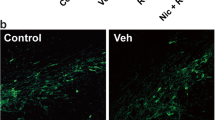Abstract
Parkinson’s disease is associated with degeneration of dopaminergic cell bodies in the substantia nigra. It has been suggested that salsolinol, an endogenous metabolite of dopamine, may be involved in this process. An inverse relationship between Parkinson’s disease and smoking (nicotine intake) has been observed in epidemiological studies. Moreover, neuroprotective effects of nicotine in various experimental models have been observed. In this study we sought to determine whether salsolinol-induced cytotoxicity in SH-SY5Y human neuroblastoma cells, a cloned cell line which expresses dopaminergic activity, could also be prevented by nicotine pretreatment, and if so, which nicotinic receptors may mediate the actions of nicotine. Exposure of SH-SY5Y cells to 0.8 mM salsolinol for 24 hours resulted in approximately 80% cell death as determined by 3,[4,5-dimethylthiazol-2-yl]-2,5-diphenyl-tetrazolium bromide (MTT) assay. Pretreatment of cells with 0.1 mM nicotine resulted in inhibition of salsolinol-induced cytotoxicity. The effects of nicotine were blocked by mecamylamine, a non-selective nicotinic antagonist as well as conotoxins with selective antagonism against alpha3-containing nicotinic receptor subunits. The effects of nicotine were not affected by dihydro-beta-erythroidine or methyl-lycaconitine, selective antagonists against alpha4-beta2 or alpha7 nicotinic receptors, respectively. It is suggested that selective nicotinic agonists may be of therapeutic potential in at least a subpopulation of Parkinsonian patients.
Similar content being viewed by others
References
Dajas-Bailador FA, L Soliakov and S Wonnacott (2002) Nicotine activates the extracellular signal-regulated kinase I/2 via the α7 nicotinic acetylcholine receptor and protein kinase A, in SH-SY5Y cells and hippocampal neurones.J. Neurochem. 80, 520–530.
Dowell C, BM Olivera, JE Garrett, ST Staheli, M Watkins, A Kuryatov, D Yoshikami, JM Lindstrom and JM McIntosh (2003) α-Conotoxin PIA is selective for α6 subunit-containing nicotinic acetylcholine receptors.J. Neurosci. 23, 8445–8562.
Gorell JM, BA Rybicki, CC Johnson and EL Peterson (1999) Smoking and Parkinson’s disease: a dose-response relationship.Neurology 52, 115–119.
Guan ZZ, WF Yu and A Nordberg (2003) Dual effects of nicotine on oxidative stress and neuroprotection in PC12 cells.Neurochem. Intl. 43, 243–249.
Hejmadi MV, F Dajas-Bailador, SM Barns, B Jones and S Wonnacott (2003) Neuroprotection by nicotine against hypoxia-induced apoptosis in cortical cultures involves activation of multiple nicotinic acetylcholine receptor subtypes.Mol. Cell. Neurosci. 24, 779–786.
Hernan MA, B Takkouche, F Caamano-Isorna and JJ Gestal-Otero (2002) A meta-analysis of coffee drinking, cigarette smoking, and the risk of Parkinson’s disease. Ann.Neurol. 52, 276–284.
Kihara T, S Shimohama, M Urushitani, H Sawada, J Kimura, T Kume, T Maeda and A Akaike (1998) Stimulation of alpha4 beta2 nicotinic acetylcholine receptors inhibits beta-amyloid toxicity.Brain Res. 792, 331–334.
Liu Q and B Zhao (2004) Nicotine attenuates beta-amyloid peptide-induced neurotoxicity, free radical and calcium accumulation in hippocampal neuronal cultures.Br. J. Pharmacol. 141, 746–754.
Lukas RJ, SA Norman and L Lucero (1993) Characterization of nicotinic acetylcholine receptors expressed by cells of the SH-SY5Y human neuroblastoma clone line.Mol. Cell. Neurosci. 4, 1–12.
Luo S, JM Kulak, GE Cartier, RB Jacobson, D Yoshikami, BM Olivera and JM McIntosh (1998) α-Conotoxin AuIB selectively blocks α3β4 nicotinic acetylcholine receptors and nicotine-evoked norepinephrine release.J. Neurosci. 18, 8571–8579.
Maruyama W, H Yi, T Takahashi, S Shimazu, H Ohde, F Yoneda, K Iwasa and M Naoi (2004) neuroprotective function of R-(-)-1-(benzufuran-2-yl)-2-propylaminopentane, [R-(-)-BPAP], against apoptosis induced byN-methyl(R)salsolinol, an endogenous dopaminergic neurotoxin, in human dopaminergic neuroblastoma SH-SY5Y cells.Life Sci. 75, 107–117.
Naoi M, W Maruyama and GM Nagy (2004) Dopamine-derived salsolinol derivatives as endogenous monoamine oxidase inhibitors: occurrence, metabolism and function in human brains.Neurotox. 25, 193–204.
Nicke A, S Wonnacott and RJ Lewis (2004) α-Conotoxins as tools for the elucidation of structure and function of neuronal nicotinic acetylcholine receptor subtypes.Eur. J. Biochem. 271, 2305–2319.
Parain K, C Hapdey, E Rousselet, V Marchand, B Dumery and EC Hirsch (2003) Cigarette smoke and nicotine protect dopaminergic neurons against the 1-methyl-4-phenyl-1,2,3,6-tetrahydro-pyridine Parkinsonian toxin.Brain Res. 984, 224–232.
Quik M, T Bordia and JM McIntosh (2004) Loss of α-conotoxin MII- and A85380-sensitive nicotinic receptors in Parkinson’s disease striatum.J. Neurochem. 88, 668–679.
Stevens TR, SR Krueger, RM Fitzsimonds and MR Picciotto (2003) Neuroprotection by nicotine in mouse primary cortical cultures involves activation of calcineurin and l-type calcium channel inactivation.J. Neurosci. 23, 10093–10099.
Storch A, A Kaftan, K Burkhardt and J Schwarz (2000) 1-methyl-6, 7-dihydroxy-1,2,3,4-tetrahydroisoquinoline (salsolinol) is toxic to dopaminergic neuroblastoma SH-SY5Y cells via impairment of cellular energy metabolism.Brain Res. 855, 67–75.
Storch A, S Ott, Y Hwang, R Ortmann, A Hein, S Frenzel, K Matsubara, S Ohta, H Wolf and J Schwarz (2002) Selective dopaminergic neurotoxicity of isoquinoline derivatives related to Parkinson’s disease: studies using heterologous expression systems of the dopamine transporter.Biochem. Pharmacol. 63, 909–920.
Tizabi Y, M Al-Namaeh, KF Manaye and RE Taylor (2003) Protective effects of nicotine on ethanol-induced toxicity in cultured cerebellar granule cells.Neurotoxicity Res. 5, 315–322.
Tizabi Y, KF Manaye, DT Smoot and RE Taylor (2004) Nicotine inhibits ethanol-induced toxicity in cultured cerebral cortical cells.Neurotoxicity Res. 6, 311–316.
Tizabi Y, KF Manaye and RE Taylor (2005) Nicotine blocks ethanol-induced apoptosis in primary cultures of rat cerebral cortical and cerebellar granule cells.Neurotoxicity Res. 7, 319–322.
Wirdefeldt K, M Gatz, Y Pawitan and NL Pedersen (2005) Risk and protective factors for Parkinson’s disease: a study in Swedish twins.Ann. Neurol. 57, 27–33.
Author information
Authors and Affiliations
Corresponding author
Rights and permissions
About this article
Cite this article
Copeland, R.L., Leggett, Y.A., Kanaan, Y.M. et al. Neuroprotective effects of nicotine against salsolinol-induced cytotoxicity: Implications for parkinson’s disease. neurotox res 8, 289–293 (2005). https://doi.org/10.1007/BF03033982
Received:
Revised:
Issue Date:
DOI: https://doi.org/10.1007/BF03033982




